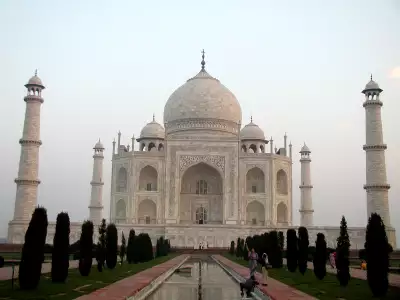Taj Mahal
Taj Mahal Wallpaper is free to download high quality desktop and mobile wallpaper with many resolutions up to 800x600 pixels
The origin of the name Taj Mahal is not certain. Court histories from Shah Jahan's reign only call it the rauza (tomb and mosque complex) of Mumtaz Mahal. It is generally believed that Taj Mahal (literally translated as "Crown Palace" or "Crown of the Palace") is an abbreviated version of Mumtaz's name. [1] (http://rubens.anu.edu.au/student.projects/tajmahal/hist_sign.html). Today, it is sometimes simply and evocatively referred to as - the Taj.
The Taj Mahal was constructed using materials from all over India and Asia. Over 1,000 elephants were used to transport building materials during the construction. The white marble was brought from Rajasthan, the jasper from Punjab and the jade and crystal from China. The turquoise was from Tibet and the Lapis lazuli from Afghanistan, while the sapphire came from Sri Lanka and the cornelian from Arabia. In all, 28 types of precious and semi-precious stones were inlaid into the white marble. The total cost of construction was about 40 million Rupees, at a time when 1 gram of gold was sold for about 1.3 Rupees.
Details of the outside wallThe architectural complex of the Taj Mahal covers an area of approximately 1900'x 1000' and comprises of five main components: the darwaza (gateway), the bageecha (garden) which is in the form of the typical Mughal charbagh (garden divided into four parts), the masjid (mosque), the mihman khana (guest house), and finally the mausoleum or the tomb of Taj Mahal, at the Northern end of the complex.
Schematic plan of Taj complexThe tomb complex was designed to be accessed from both the Northern and the Southern sides, from the river Yamuna as well as by land. The entry from the landside has the gateway and other utility buildings constituting the front (and Southern) part of the complex. On entering the gateway which visually frames the tomb, one is inside the charbagh. Measuring 1000' x 1000', the garden has sunken parterres or flower-beds, raised pathways, water channels that reflect the Taj and avenues of trees. At the termination and along the central axis articulated by the garden is the tomb. To the Western or Mecca side of the tomb is a mosque of red sandstone that sanctifies the complex and provides a place for pilgrims to worship. On the Eastern side is a structure that duplicates the mosque in order to maintain architectural symmetry. This is known as the jawab ("answer") and was put to use as a guest house.
Gateway to the Taj Mahal, view from CharbaghThe tomb of Queen Mumtaz Mahal stands on a raised terrace with four minarets at each corner framing the tomb. The minarets are believed to slant outwards so that in the event of an earthquake they will fall away from the tomb. Like most Mughal tombs, the Taj shows a lot of Persian influence. A derivative of a square in plan with edges chamfered, it is a multi-chambered structure with a central main chamber surrounded by eight divisions ( of which four are important bays) with openings in the form of arched alcoves. The central chamber is surmounted by a bulbous double dome (having inner and outer layers) generally referred to as the onion or Tartar or Persian dome because of its form. There are four chattris (small domes over pavilions) over the surrounding bays which articulate the main dome. The cenotaph is at the entry level of the main chamber whereas the grave is at the level below. The black and white chessboard marble floor inside the tomb chamber and the pietra dura artwork that includes geometric patterns, plants & flowers are impressive.
Various studies on the Taj speculate on what makes it unique and beautiful. One reason is attributed to its perfect proportions and geometry. Another is ascribed to the various moods that the Taj presents to its viewers. Clad in delicate, white Makrana marble, the Taj changes its character across time as the light changes- dawn, noon, twilight, night. The shadows that fall on the marble too enhance the effect, being very delicate. The Taj is considered especially etheral when viewed on a full moon night. For Tagore, the Taj was a "tear in the face of eternity".
Taj Mahal, view from South-Eastern gardensAn unlikely legend claims that after the completion of the Taj Mahal, Shah Jahan had the eyes of architect Ustad Ahmed gouged, ensuring that nothing could be built competing with its magnificence.
An identical complex was originally supposed to be built on the other side of the river, in black marble instead of white. There is some archaeological evidence to support this theory. If plans for such a structure did exist, however, it was never completed for unknown reasons.
As part of the struggle for succession, Shah Jahan was put under house arrest at nearby Agra Fort by his son Aurangzeb, and legend has it that he spent the remainder of his days there gazing from a window at the Taj. He was buried in the Taj Mahal, next to his wife.
By the late 19th century, parts of the Taj Mahal had fallen badly into disrepair, and some of the cut marble had been stolen for use elsewhere. British viceroy Lord Curzon ordered a restoration project. At the same time the traditional garden was replaced with the more English-looking lawns that are visible today.
The Taj Mahal, as of 1983, is an UNESCO World Heritage Site and a major tourist destination (source: www.wikipedia.com)







